Attached files
| file | filename |
|---|---|
| 8-K - 8-K - LA JOLLA PHARMACEUTICAL CO | a19sep16presentation.htm |
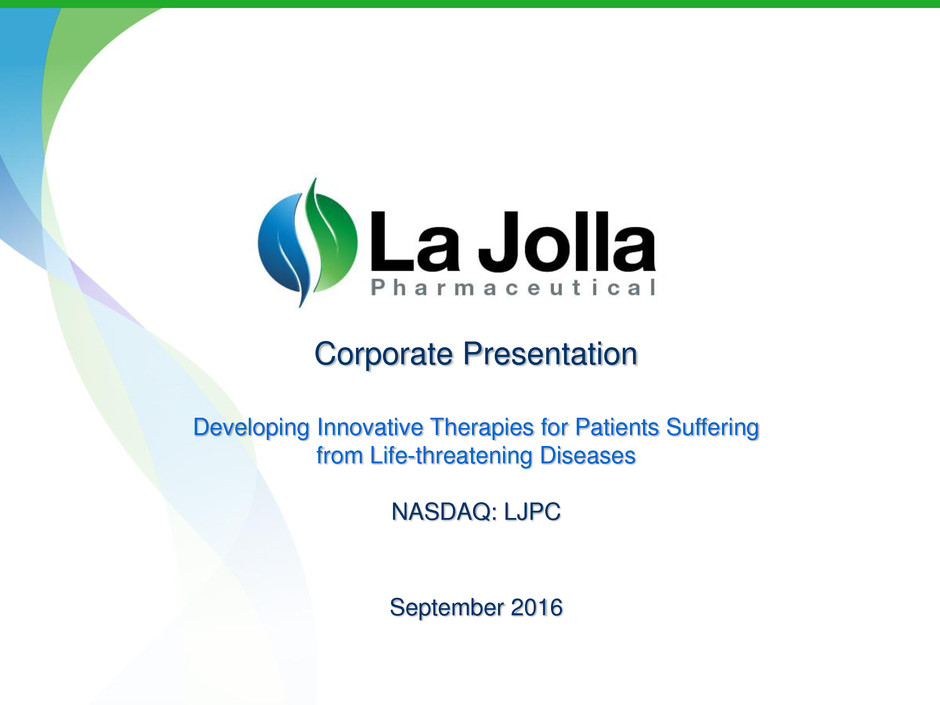
September 2016
Developing Innovative Therapies for Patients Suffering
from Life-threatening Diseases
NASDAQ: LJPC
Corporate Presentation

Forward-Looking Statements
These slides contain "forward-looking" statements within the meaning of the Private Securities Litigation
Reform Act of 1995. These statements may be identified by the use of forward-looking terminology such
as "anticipate", "believe", "continue", "could", "estimate", "expect", "intend", "may", "might", "plan",
"potential", "predict", "should" or "will" and include statements regarding La Jolla’s product candidates
and clinical trial progress and results. These forward-looking statements are based on our current
expectations and beliefs, speak only as of the date of this presentation and involve risks and
uncertainties, many of which are outside of our control, that can cause actual results to differ materially
from those anticipated in the forward-looking statements. Potential risks and uncertainties include, but
are not limited to: our ability to commence and complete clinical studies within projected time periods,
the degree to which initial clinical study results are indicative of expected results for future studies,
anticipated regulatory and patent exclusivity periods, the ability to manufacture clinical or commercial
products successfully, the ability to resolve regulatory issues, the ability to out-license programs,
estimated market sizes and anticipated pricing levels for drug candidates, anticipated rates of physician
adoption, if our drug candidates are approved, the ability to successfully develop our product
candidates, including the results of ongoing and future clinical trials (including product safety issues and
efficacy results), the ability to successfully prosecute patents and whether such patents will confer
protection for our product candidates, and the expected duration of the Company’s operating runway
based on current cash resources. Further information regarding these and other risks that could affect
our future results of operations are included in La Jolla’s most recently filed Annual Report on Form 10-
K and subsequent Quarterly Reports on Form 10-Q under the caption “Risk Factors,” as filed with the
U.S. Securities and Exchange Commission at www.sec.gov. We disclaim any intent to update any
forward-looking statements to reflect actual events that occur after the date of this presentation.
2

• Overview of LJPC
• LJPC-501 (Angiotensin II) for CRH
• LJPC-401 (Synthetic Hepcidin) for Iron
Overload
• LJPC-30S (Gentamicin Derivative) for
Bacterial Infections and
Rare Genetic Diseases
• Financial Position
Agenda
3

Mission Statement
La Jolla is dedicated to improving the
lives of patients suffering from life-
threatening diseases by discovering and
developing innovative therapies
4

LJPC Corporate Highlights
• Focused on de-risked product opportunities
Naturally occurring peptides with well-understood biological functions
Derivative components of FDA-approved products
• LJPC-501 (angiotensin II) for catecholamine-resistant hypotension (CRH)
Phase 3 registration study (under SPA) actively enrolling
• LJPC-401 (synthetic hepcidin) for iron overload caused by diseases such
as hereditary hemochromatosis (HH), thalassemia, sickle cell disease
(SCD) and myelodysplasia (MDS)
Positive Phase 1 study results reported in September 2016
Agreement reached with EMA on pivotal study design
• LJPC-30S (gentamicin derivative) for bacterial infections and rare genetic
diseases
Positive pre-IND feedback received
5

Product Pipeline
Underway Completed Planned
6
LJPC-501
Angiotensin II
LJPC-401
Synthetic Hepcidin
Other R&D
Indication IND Phase 1 Phase 2 Phase 3
CRH
Sept.
2016
Various
Q1
2017
HH, Thalassemia,
SCD and MDS
Q4
2015
LJPC-30S
Gentamicin Derivative
Bacterial
Infections/Rare
Genetic Diseases
Q1
2015
Successful
Pre-IND
Meeting
Mid-
2017
Pivotal Study
Pivotal Study

• Overview of LJPC
• LJPC-501 (Angiotensin II) for CRH
• LJPC-401 (Synthetic Hepcidin) for Iron
Overload
• LJPC-30S (Gentamicin Derivative) for
Bacterial Infections and
Rare Genetic Diseases
• Financial Position
Agenda
7

LJPC-501: Overview
8
• LJPC-501 is a proprietary formulation of angiotensin II, a naturally
occurring regulator of blood pressure
• Catecholamine-resistant hypotension (CRH) is an acute, life-threatening
condition in which blood pressure drops to dangerously low levels and is
unresponsive to current treatments
• LJPC-501 has been shown to raise blood pressure in a pilot,
randomized, placebo-controlled, clinical trial in CRH, as well as animal
models of hypotension
• Special Protocol Assessment (SPA) agreement reached with FDA
Agreement reached that blood pressure can be the primary endpoint for approval
• Phase 3 trial actively enrolling
Top-line results expected in Q1 2017
• Issued patent claims covering potential product to 2034

Three Systems Work in Harmony to
Regulate Blood Pressure
9
Current therapeutic
options for the
treatment of acute
hypotension only
leverage the adrenal
system and
vasopressin system
The Body’s Three Systems that
Regulate Blood Pressure

High Doses of Catecholamines
Increase Mortality
10
Sources: Sviri et al, J. of Crit Care, 29;157-160, 2014 and Morelli et al, JAMA Oct23/30, 310:1683-1691, 2013
• Catecholamines (i.e.,
norepinephrine,
epinephrine and
dopamine) cause
cardiac toxicity, digital
necrosis and metabolic
complications leading
to higher mortality
• Blocking the cardiac
toxicity of norepinephrine
improves outcome
0
10
20
30
40
50
60
70
80
90
Low Dose Hi Dose
P
e
rc
e
n
tage
s
Norepinephrine Dose
Alive Dead
Mortality Rates in ICU Based on
Norepinephrine Dose1

Norepinephrine Dose Decreases with Angiotensin II
Surrogate Effect on Blood Pressure
11
Source: Chawla et al, Critical Care, 18:534, 2014
• Randomized,
placebo-controlled,
double-blind pilot trial
• Primary efficacy
endpoint:
Catecholamine dose
sparing; surrogate for
BP effect
• Published October
2014 in Critical Care
• All angiotensin II
patients experienced
an increase in BP
• Strong proof-of-
concept that
angiotensin II
increases blood
pressure in CRH
0
5
10
15
20
25
30
35
40
45
50
Pre2 Pre1 Hr0 Hr1 Hr2 Hr3 Hr4 Hr5 Hr6 Post1 Post2
N
o
repi
n
ep
h
rin
e
Do
s
e
(
m
c
g
/m
in
)
Placebo AT-II Arm
p<0.05
Catecholamine
Resistance

LJPC-501: Phase 3 Trial in CRH
SPA Agreement with FDA Reached, Trial Enrolling
12
• ATHOS (Angiotensin II for the Treatment of High-Output Shock) 3 trial
initiated in March 2015
• Randomized, placebo-controlled, double-blind Phase 3 trial
• Patient population: catecholamine-resistant, based on amount of
catecholamine required
• Primary endpoint: blood pressure at 3 hours
• Secondary endpoints: change in CV SOFA* score; safety and tolerability of
LJPC-501 in CRH patients
• Size: ~315 patients
• Projected top-line results: Q1 2017
*Cardiovascular Sequential Organ Failure Assessment

U.S. Acute Hypotension Patient Population
and Treatment Paradigm
13
18.84MM annualized vials (737K vials sold in July 2016 X 12); Symphony Health Solutions, 2016. 97% of vials sold for hypotensive shock;
estimate based on medical literature. 13 vials used per patient; estimate based on Russell et al, N Engl J Med, 358:877-87, 2008 and Asfar et
al, N Engl J Med, 370:1583-93, 2014
2Wolters Kluwer PriceRx Pro, 2016
33.05MM annualized vials (254K vials sold in July 2016 X 12); Symphony Health Solutions, 2016. 90% of vials sold for hypotensive shock;
estimate based on medical literature. 10 vials used per patient; estimate based on Dunser et al, Circulation, 107:2313-2319, 2003 and Gordon
et al, Crit Care Med, 42(6):1325-1333, 2014
First-Line
Standard-of-Care
Second-Line
Standard-of-Care
LJPC-501 Target
Patient Population
555,479
361,684
332,189 Patient Who Do Not
Adequately Respond
to Norepinephrine
and Vasopressin
Vasopressin:
274,000 Patients per Year3
$1,385 per Patient2
$379MM Sales Run Rate
Norepinephrine:
659,000 Patients per Year1
$153 per Patient2
$101MM Sales Run Rate

LJPC-501: Summary
14
• LJPC-501 is a proprietary formulation of angiotensin II, a naturally
occurring regulator of blood pressure
• Catecholamine-resistant hypotension (CRH) is an acute, life-threatening
condition in which blood pressure drops to dangerously low levels and is
unresponsive to current treatments
• LJPC-501 has been shown to raise blood pressure in a pilot,
randomized, placebo-controlled, clinical trial in CRH, as well as animal
models of hypotension
• Special Protocol Assessment (SPA) agreement reached with FDA
Agreement reached that blood pressure can be the primary endpoint for approval
• Phase 3 trial actively enrolling
Top-line results expected in Q1 2017
• Issued patent claims covering potential product to 2034

• Overview of LJPC
• LJPC-501 (Angiotensin II) for CRH
• LJPC-401 (Synthetic Hepcidin) for Iron
Overload
• LJPC-30S (Gentamicin Derivative) for
Bacterial Infections and
Rare Genetic Diseases
• Financial Position
Agenda
15

LJPC-401: Overview
• LJPC-401 is a novel formulation of synthetic hepcidin, a naturally
occurring regulator of iron absorption and distribution
• Primary iron overload
Hereditary hemochromatosis (HH) is characterized by a genetic deficiency of
hepcidin resulting in excessive iron accumulation
– Most common genetic disease in Caucasians
– Causes liver cirrhosis, liver cancer, heart disease and/or failure, and diabetes
• Secondary iron overload
Patients with thalassemia (including beta thalassemia), sickle cell disease (SCD)
and myelodysplasia (MDS) have physiologically low hepcidin levels and are
treated with blood transfusions, resulting in acquired iron overload
• LJPC-401 has been shown to be effective at reducing serum iron levels in
preclinical and Phase 1 human testing
• Scalable manufacturing process capable of producing a pure, properly
folded, stable hepcidin formulation developed
16
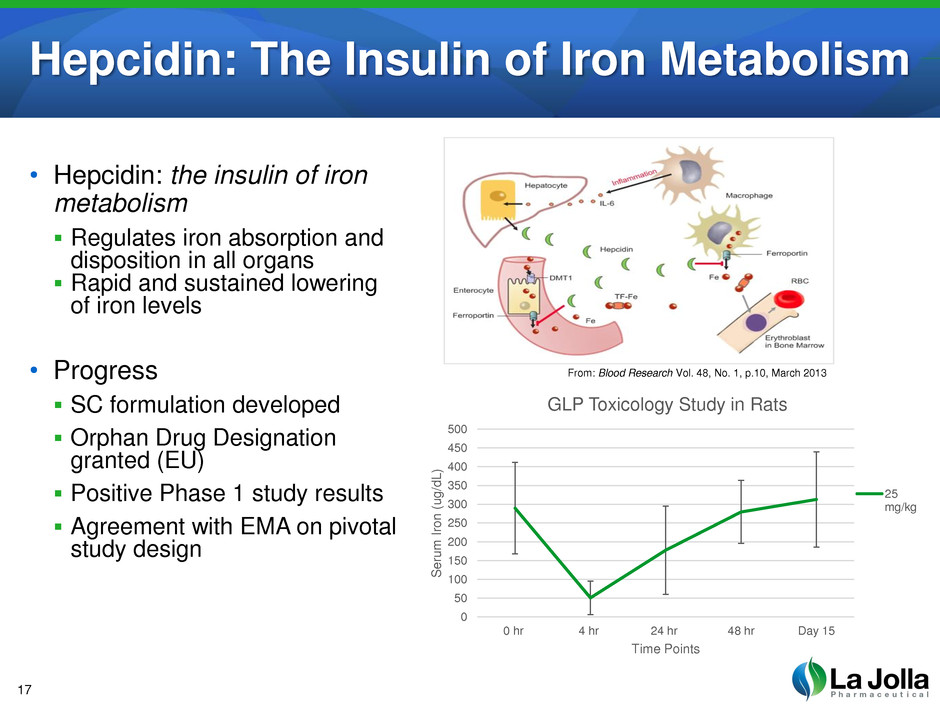
Hepcidin: The Insulin of Iron Metabolism
• Hepcidin: the insulin of iron
metabolism
Regulates iron absorption and
disposition in all organs
Rapid and sustained lowering
of iron levels
• Progress
SC formulation developed
Orphan Drug Designation
granted (EU)
Positive Phase 1 study results
Agreement with EMA on pivotal
study design
17
From: Blood Research Vol. 48, No. 1, p.10, March 2013
0
50
100
150
200
250
300
350
400
450
500
0 hr 4 hr 24 hr 48 hr Day 15
S
eru
m
Iron (ug/
d
L
)
Time Points
GLP Toxicology Study in Rats
25
mg/kg

PRIMARY ENDPOINT
Safety and tolerability
via review of: Treatment
Emergent Adverse Events
(TEAEs), changes in clinical
lab values, ECGs, vital sign
and physical exam data
SECONDARY ENDPOINT
Serum iron
LJPC-401: Phase 1 Study Design
• Population: Adult
patients at risk of iron
overload (e.g., HH,
thalassemia, SCD)
• Design: Phase 1, open-
label, dose-escalation,
study
• Study Duration: Single
SC dose, 7-day
observation
Escalating dose levels
3 to 6 subjects at each
dose level
18
Data Monitoring Committee (DMC)
made dose-escalation decisions

LJPC-401: Phase 1 Results Overview
• Fifteen patients dosed at escalating dose levels from 1 mg to 20 mg
Patient subtypes treated: HH = 10; SCD = 3; and thalassemia = 2
• Safety observations
No dose-limiting toxicities at any dose level
1 SAE at 1 mg dose level unrelated to study drug
– Hospitalization for acute sickle cell crisis; fully resolved
9 injection-site reactions – all were mild or moderate in severity, self-limiting,
and fully resolved
No significant changes in serum chemistries or hematology other than serum
iron parameters
• Pharmacodynamic results
Dose-dependent, statistically significant reduction in serum iron (p=0.008)
Maximum serum iron reduction observed at 8 hours post-dose
Durable effect observed through last observation on Day 7
19

Dose Response
p=0.008
Individual dose p-values for change from baseline not adjusted for a potential regression to the mean effect.
Dose response not adjusted for multiple comparisons.
LJPC-401: Percent Change in Serum Iron
Baseline to Hour 8
20
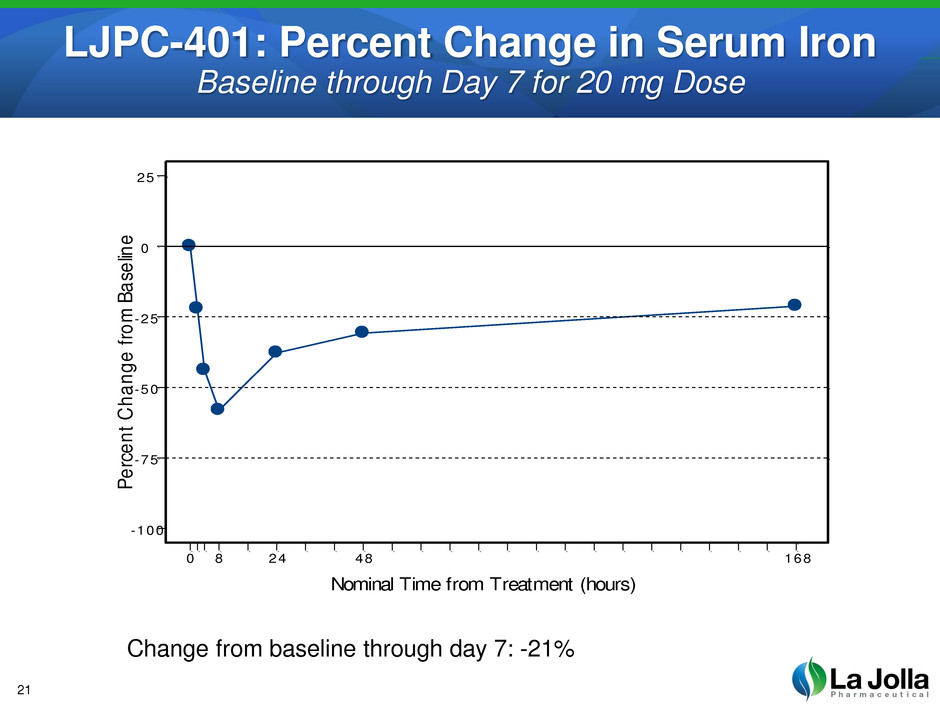
Nominal Time from Treatment (hours)
Pe
rce
nt
C
ha
ng
e
fro
m
Ba
se
lin
e
(%
)
0 8 24 48 168
-100
-75
-50
-25
0
25
Serum Iron: Percent Change from Baseline
Change from baseline through day 7: -21%
LJPC-401: Percent Change in Serum Iron
Baseline through Day 7 for 20 mg Dose
21

LJPC-401: Phase 1 Results Summary
• Fifteen patients received a single dose ranging from 1 mg to 20 mg
Patient subtypes treated: HH = 10; SCD = 3; and thalassemia = 2
• Well tolerated with no dose-limiting toxicities
Mild to moderate, transient and self-limiting injection-site reactions
• Profound and durable reduction in serum iron observed
Statistically significant dose response (p=0.008)
A single 20 mg dose resulted in a 58% reduction at hour 8, with levels still not
returning to baseline through day 7 (21% reduction)
Iron effect consistent with that observed in preclinical models
22
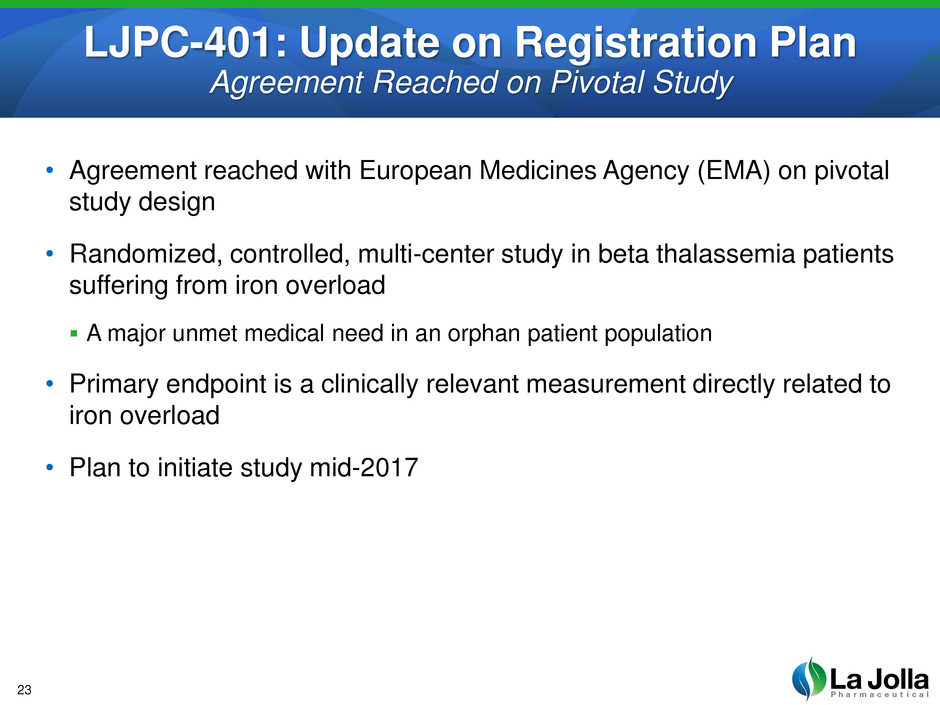
• Agreement reached with European Medicines Agency (EMA) on pivotal
study design
• Randomized, controlled, multi-center study in beta thalassemia patients
suffering from iron overload
A major unmet medical need in an orphan patient population
• Primary endpoint is a clinically relevant measurement directly related to
iron overload
• Plan to initiate study mid-2017
LJPC-401: Update on Registration Plan
Agreement Reached on Pivotal Study
23
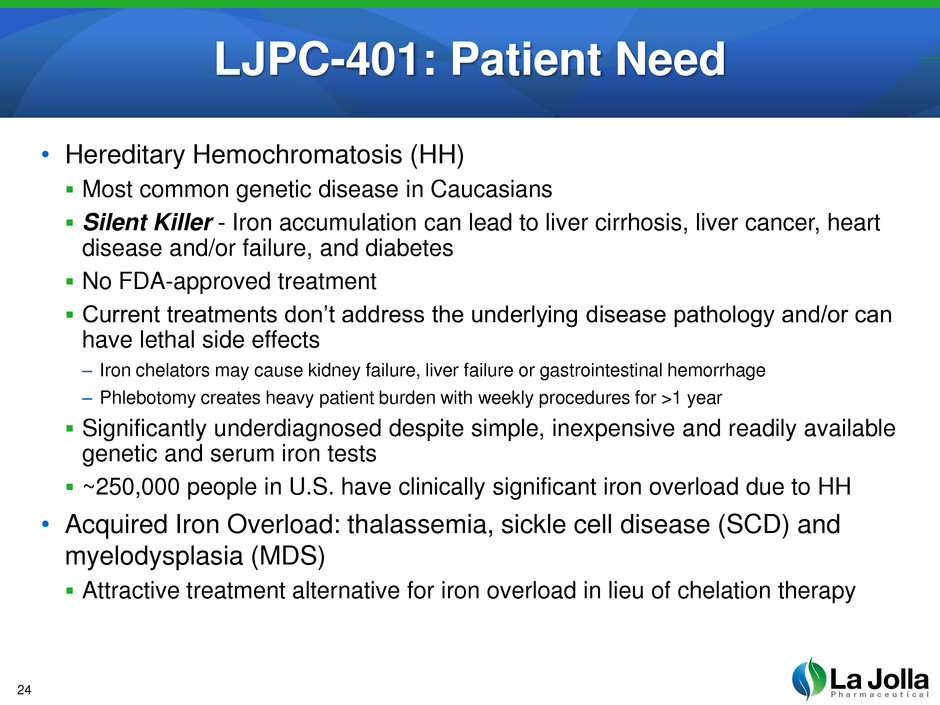
LJPC-401: Patient Need
• Hereditary Hemochromatosis (HH)
Most common genetic disease in Caucasians
Silent Killer - Iron accumulation can lead to liver cirrhosis, liver cancer, heart
disease and/or failure, and diabetes
No FDA-approved treatment
Current treatments don’t address the underlying disease pathology and/or can
have lethal side effects
– Iron chelators may cause kidney failure, liver failure or gastrointestinal hemorrhage
– Phlebotomy creates heavy patient burden with weekly procedures for >1 year
Significantly underdiagnosed despite simple, inexpensive and readily available
genetic and serum iron tests
~250,000 people in U.S. have clinically significant iron overload due to HH
• Acquired Iron Overload: thalassemia, sickle cell disease (SCD) and
myelodysplasia (MDS)
Attractive treatment alternative for iron overload in lieu of chelation therapy
24
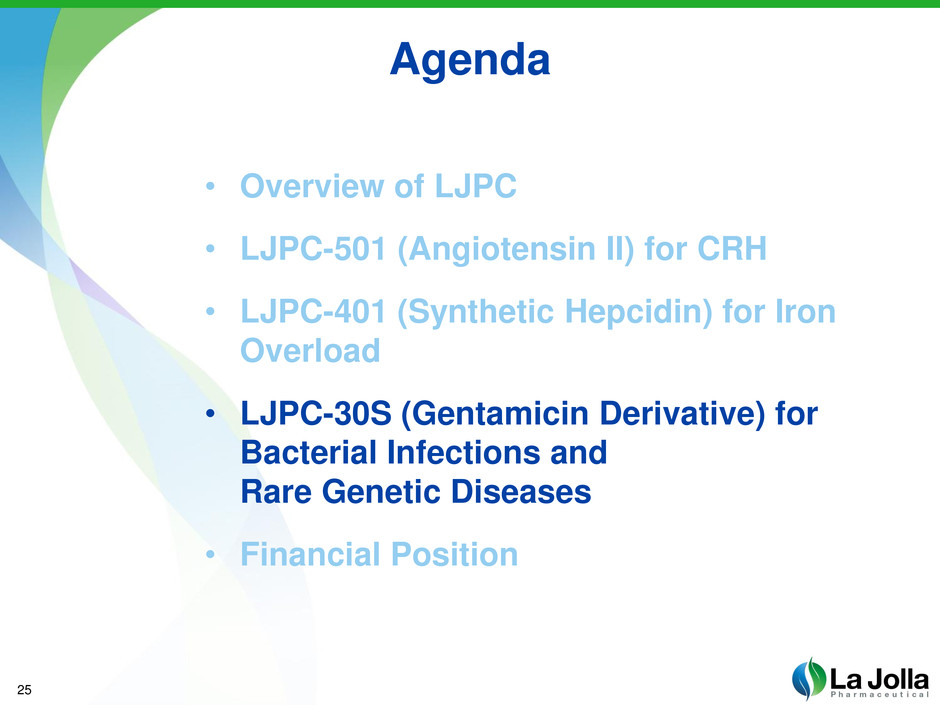
• Overview of LJPC
• LJPC-501 (Angiotensin II) for CRH
• LJPC-401 (Synthetic Hepcidin) for Iron
Overload
• LJPC-30S (Gentamicin Derivative) for
Bacterial Infections and
Rare Genetic Diseases
• Financial Position
Agenda
25

LJPC-30S: Overview
• LJPC-30S is a purified derivative of gentamicin, which retains biologic
activity but lacks traditional kidney toxicity
• Gentamicin: FDA-approved, standard-of-care for serious Gram-negative
bacterial infections
Mixture of several distinct but closely related chemical entities
>3 million vials of gentamicin used in the U.S. in 2015
Use is limited due to kidney toxicity, which is believed to be associated only with certain
constituent components
• Two target market opportunities
Bacterial infections: aminoglycosides = $500+ million market in the U.S.1
Rare genetic diseases: gentamicin’s mechanism may be leveraged for rare genetic
diseases; proof-of-concept data exists in cystic fibrosis
• Recent positive FDA feedback on Phase 1 proposal
• Multiple points of potential proprietary protection
Potential regulatory exclusivity and Orphan Drug Designation
Antibiotic exclusivity: 8+ years including Hatch-Waxman + GAIN (QIDP)
IP optioned from IU and UAB
26
15.7MM vials is an estimated 300K regimens X an average wholesale acquisition cost (WAC) of $2,491 per regimen for
branded, intravenous only antibiotics (n=7); Symphony Health Solutions, 2016, medical literature and Wolters Kluwer
PriceRx Pro, 2016

Next-generation improved gentamicin derivative
1. Retain activity
LJPC-30S: Potential for
Improved Clinical Profile
27
2. Improve safety
0.0
4.0
8.0
12.0
16.0
placebo next-generation
gentamicin
derivative
gentamicin
In
h
ibi
tio
n
/k
ill
z
o
n
e (
m
m
)
B.subtilus K.pneumonieae (kill) K.pneumonieae (inhib)
0
0.1
0.2
0.3
0.4
0.5
0.6
0.7
S
e
ru
m
Cr
e
ati
n
ine
m
g
/d
L
placebo
next-
generation
gentamicin
derivative
gentamicin

Gentamicin induces errors in the translation of genes into proteins
Bacteria
LJPC-30S: Mechanism of Action Can Be Leveraged
Toward Two Therapeutic Opportunities
28
Alters protein synthesis leading
to cell death
Alters protein synthesis to allow read
through of stop-codon mutations
Humans

LJPC-30S: Clinical Proof-of-Concept in
Cystic Fibrosis
29
Sources: Sermet-Gaudelus et al, BMC Medicine, 5:5, 2007; Wilchanski et al, NEJM, 349:1433-41, 2003 and Clancy
J.P. et al, Am J Respir Crit Care Med, 163:1683-1692, 2001
• Three, independent studies suggest gentamicin helps read
through stop-codon mutations in cystic fibrosis
Study of 10 mg/kg IV gentamicin over 15
days in Y122X mutations leads to:
Improvement in cystic fibrosis clinical scores
(p=0.007)
– Improvements seen as early as day 4
Improvement in lung function (FEV1)
independent of an antimicrobial effect
(p=0.04)
Improvement in sweat chloride secretion
(p=0.03) and nasal potential difference
(p=0.04)
• Dose-dependent effect suggests LJPC-30S could allow chronic
dosing with better efficacy and no kidney toxicity
Sweat Chloride Secretion
Improvement after Gentamicin
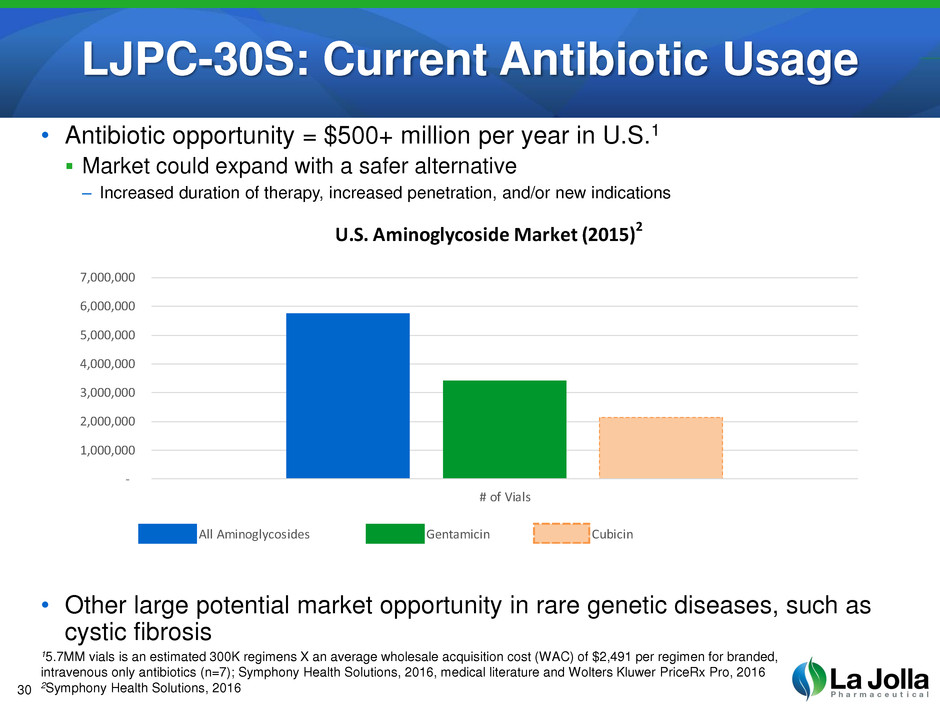
LJPC-30S: Current Antibiotic Usage
• Antibiotic opportunity = $500+ million per year in U.S.1
Market could expand with a safer alternative
– Increased duration of therapy, increased penetration, and/or new indications
• Other large potential market opportunity in rare genetic diseases, such as
cystic fibrosis
30
15.7MM vials is an estimated 300K regimens X an average wholesale acquisition cost (WAC) of $2,491 per regimen for branded,
intravenous only antibiotics (n=7); Symphony Health Solutions, 2016, medical literature and Wolters Kluwer PriceRx Pro, 2016
2Symphony Health Solutions, 2016
All Aminoglycosides Gentamicin Cubicin
U.S. Aminoglycoside Market (2015)2
-
1,000,000
2,000,000
3,000,000
4,000,000
5,000,000
6,000,000
7,000,000
# of Vials

• Overview of LJPC
• LJPC-501 (Angiotensin II) for CRH
• LJPC-401 (Synthetic Hepcidin) for Iron
Overload
• LJPC-30S (Gentamicin Derivative) for
Bacterial Infections and
Rare Genetic Diseases
• Financial Position
Agenda
31
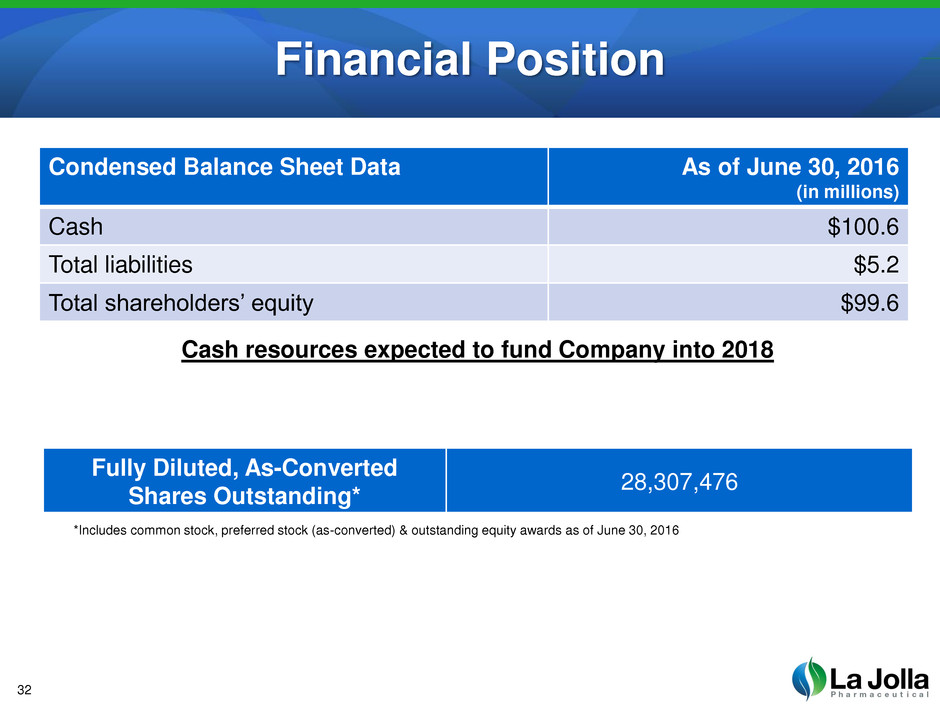
Financial Position
32
Condensed Balance Sheet Data As of June 30, 2016
(in millions)
Cash $100.6
Total liabilities $5.2
Total shareholders’ equity $99.6
Fully Diluted, As-Converted
Shares Outstanding*
28,307,476
*Includes common stock, preferred stock (as-converted) & outstanding equity awards as of June 30, 2016
Cash resources expected to fund Company into 2018

LJPC Corporate Highlights
• Focused on de-risked product opportunities
Naturally occurring peptides with well-understood biological functions
Derivative components of FDA-approved products
• LJPC-501 (angiotensin II) for catecholamine-resistant hypotension (CRH)
Phase 3 registration study (under SPA) actively enrolling
• LJPC-401 (synthetic hepcidin) for iron overload caused by diseases such
as hereditary hemochromatosis (HH), thalassemia, sickle cell disease
(SCD) and myelodysplasia (MDS)
Positive Phase 1 study results reported in September 2016
Agreement reached with EMA on pivotal study design
• LJPC-30S (gentamicin derivative) for bacterial infections and rare genetic
diseases
Positive pre-IND feedback received
33

Thank You
